Pre-Release Report: Adobe Photoshop CS3 Extended
##AUTHORSPLIT##<--->
3/28/2007—With the completely revamped education licensing program Adobe has now implemented with the launch of Creative Suite 3, K-12 schools are in a better position than ever to adopt higher-end graphic, publishing, and Web design tools, as well as video and motion graphics apps, and integrate them into the learning environment. So this week we'll be taking a look at the significant new features in the applications in the various Creative Suite 3 editions, starting off today with what is probably the most significant application of the bunch: Photoshop CS3 Extended.
As Adobe announced earlier this month, its most widely used creative application--and one of the most widely used applications period--has ben split into two versions: Photoshop CS3 Standard and Photoshop CS3 Extended. For the K-12 market, the release also coincided with new licensing, adopted and adapted from Macromedia's previous practices, that allows schools to puchase 500 seats of the individual Creative Suite editions at about 1 percent the commercial price for that many licenses. (For example, the Master Collection, which would cost $1.25 million for 500 seats purchased individually, runs $12,500 for a schoolwide license and includes student and teacher home use. Please see the links at the end of this article for current K-12 licensing details.)
We took a brief look at Photoshop CS3 Standard a few onths back, as the public beta was released. But the Extended edition is a much more radical advancement in graphic design software, incorporating all of the new features, improvements, and compatibility updates, but adding in new specialized features for 2D and 3D designers, motion graphics artists, video editors, engineers, and even medical professionals.
We've had our hands on this Extended edition for a couple months now and can finally share all of the details with you in this, our first installment of hands-on previews of the new applications in Adobe Creative Suite 3. We'll take a look at Photoshop CS3's new performance improvements (including preliminary benchmarks) and new features exclusive to the Extended edition.
It should be noted that this is a preliminary look at a pre-release version of Photoshop CS3 Extended, not a formal software review, so we won't be touching on any of the quirks or instabilities in the beta release that are likely to be weeded out prior to the final release. Instead, we'll focus on new features--especially those unique to the Extended version of Photoshop--and also look at preliminary performance benchmarks.
Performance, compatibility, Universal Binarification
Now, the the group probably most impacted by the release of Creative Suite 3 is the Mac crowd. They have, after all, been stuck in Adobe limbo for more than a year now, waiting for Intel-native versions of Adobe's creative software. And now, here it comes, all at once, with Photoshop CS3 Extended at the vanguard.
Both Photoshop CS3 Standard and Photoshop CS3 Extended--along with most other apps in the various Creative Suite editions--are now offered as Universal Binaries, meaning that they're natively compatible with other PowerPC- and Intel-bsed Mac hardware. (Some of the apps, such as Premiere Pro, Encore, and a couple others run only on Intel-based Mac hardware and do not support PowerPC-based Macs.)
So what does this native compatibility mean for Mac users?
Performance.
While I'm loath to perform benchmark tests on beta software, I have to make an exception in this case because all of my benchmarks are favoring this beta over the previous full release of Photoshop (CS2) on Intel-based Mac hardware and pretty much anything else I've tested previous releases of Photoshop on.
Here's the way it looks.
I ran three extensive tests comparing the performance of Photoshop CS3 Extended against Photoshop CS2 running on both Mac OS X and Windows XP Professional SP2 on exactly the same machine (an Intel Core Duo-based MacBook running at 2.0 GHz). Here re the details of the tests.
- Test 1: A 4,000 x 4,000-pixel document was created, and on this document I applied 47 commands, including 28 individual filters and 19 image adjustments, layer and canvas transformations, and various other actions.
- Test 2: A 2,000 x 1,500-pixel document was created, with a variety of commands applied, including several canvas- and layer-based transformations in succession.
- Test 3: An 800 x 600-pixel document was created, and to that document every filter that ships with Photoshop (CS2) was applied, with the exception of Reduce Noise and Displace. The test also included transformations, selections, fills, and the manipulation of text.
Here are the results. (Click for larger image.)
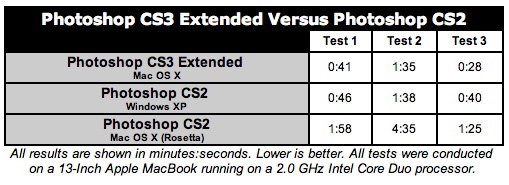
As you can see, even in beta form--and even with the additional overhead the new version is carrying--Photoshop CS3 Extended is drastically outperforming Photoshop CS2 on the same hardware--especially against CS2 running in emulation mode under Mac OS X. (I have not tested Photoshop CS3 Extended running on Windows.)
Photoshop CS3 Extended, like Photoshop CS3 Standard, also gains compatibility with Windows Vista (in addition to Windows XP.)
'Extended' creative featuresBut the fun doesn't end with performance improvements. It also adds some new features that will be critical to users across creative departments, including those working in video and motion graphics and those working in 3D or incorporate 3D into their 2D design projects.
Video featuresFirst up: the video features. Anybody upgrading to Adobe After Effects CS3 or Premiere Professional CS3 (now also available for Intel-based Macs, but not PowerPC-based Macs) is also going to need/want/crave Photoshop CS3 Extended. The reason for this is that the Extended version gains a number of enhancements that turn Photoshop into a rotoscoping, animation, and video enhancement demon.
Unlike previous versions of Photoshop, it can open QuickTime and Windows Media files straight from the File menu, without any manual import or individual frames required. (This was a big drag in Photoshop CS2.) Now a user can just open a video file as if it were a still image file and begin working on it immediately.
And, once you have the video opened, working with it is very similar to working with video in After Effects or Premiere Pro (or any other NLE or motion graphics package, for that matter). The newly revised Animation palette is similar in feel and functionality to the timeline in After Effects or Premiere. And it adds in several new functions as well.
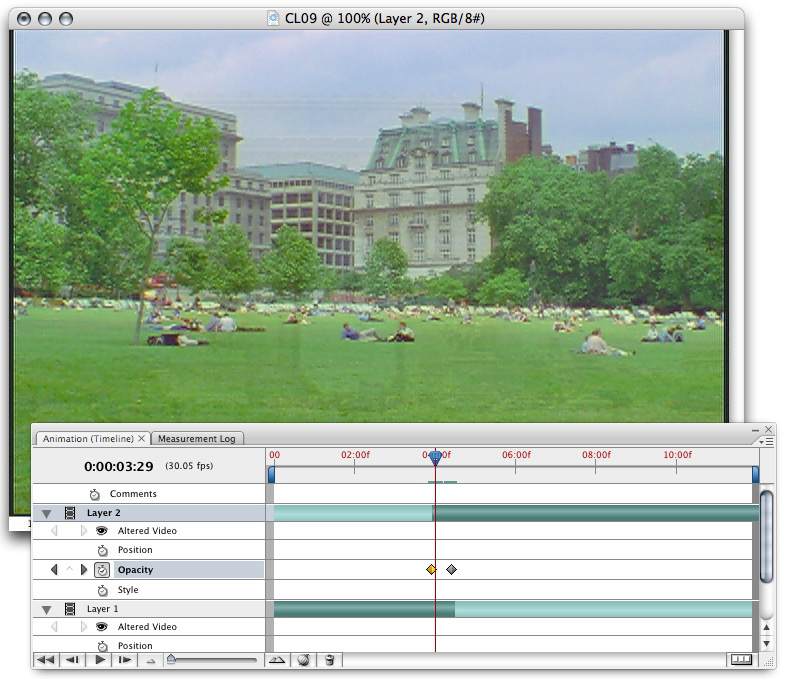 (Click for larger image.)
(Click for larger image.)These include:
- Support for multiple layers of video;
- Traditional keyframing of position and opacity (to create dissolves and the like); and
- Support for keyframing of layer styles (such as Drop Shadow, Pattern Overlay, etc.).
In addition to this, Photoshop CS3 Extended also supports rotoscoping with the program's built-in paint and cloning tools. So users can paint frame by frame or touch up frames one at a time. They can also use the Cone tool to clone pixels from one frame onto another to help clean up damaged footage or remove artifacts.
Also for the first time in any incarnation of Photoshop, the Extended version allows users to export video as video by rendering it to any number of supported file types and codecs. These include: Windows Media, QuickTime, FLC, 3G, iPod video, AVI, DV stream, image sequence, MPEG-4, and--bum bum bum--Flash Video (FLV).
Video is exported through a new command at File > Export > Render Video. This command calls up a settings dialog that allows users to choose the format, set a frame range, apply cropping or fitting, and select a codec (for audio and video) along with the codec's settings (data rate, quality, bit depth, etc.).
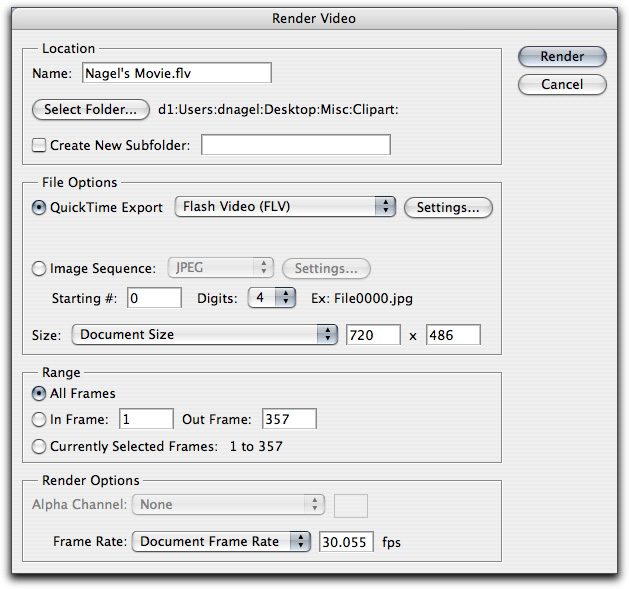 (Click for larger image.)
(Click for larger image.)The Flash Video export support MP3 for audio and both Sorenson Spark and On2 VP6 for video.
And finally, in addition to al that, the Photoshop file format now natively supports video layers. In other words, not only is video imported as a single layer and behaves just like any other layer, but video layers (plural) can also be stored in the document itself.
This, of course, saves on render times, but it's particularly useful in that both After Effects and Premiere Pro will, in their upcoming releases, support this new file format natively. So Photoshop documents that contain video can be opened natively, and no further conversion is required.
It's worth noting in the context of After Effects that Photoshop C3 Extended does support multiple bit-depths on video layers, including 8-, 16-, and 32-bit HDR, along with multiple color modes (RGB, CMYK, Lab, and grayscale). And it supports color management for video.
3D featuresNow, you've also no doubt herd about Photoshop CS3 Extended's 3D capabilities. But what does that mean? Is Photoshop trying to compete with Maya, 3DS Max and the rest of the 3D modeling and animation programs out there? No indeed. In fact, it's trying to work with them.
Virtually every 3D artist uses Photoshop in one way or another--for creating textures, for working with materials, etc. Now in Photoshop, users can import 3D objects directly to the canvas and modify textures on the fly while also being able to see the results instantly on their models.
Just as with video, Photoshop can open 3D files directly from the File menu, including OBJ, 3DS, KMZ (Google), Collada, and U3D. These file formats are al common export options for 3D modeling, animation, and CAD programs. And, just as with video files, these 3D layers can be manipulated in many ways like standard 2D layers, including blending options, layer styles, etc. (but no regular filters).
In addition, Photoshop also provides a variety of tools for transforming the 3D objects and cameras that are imported, including rotation, roll, orbit, horizontal and vertical position, and zoom, among others.
It also provides controls over lighting and rendering. Photoshop does not allow you to create new lights, but it does let you display the object through the lighting set in the 3D file or through a variety of presets (a single point light, day lights, night lights, and many more). And it lets you choose the render preview display (shaded, wireframe, vertices, etc.)
The screen shot below shows several of these features.
 (Click for larger image.)
(Click for larger image.)Photoshop can also create cross sections of the 3D model on multiple axes.
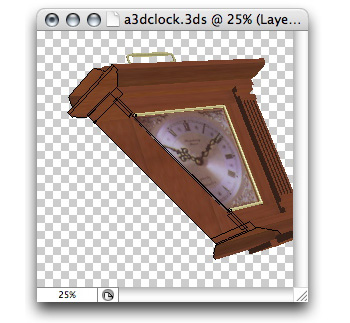
Photoshop CS3 Extended is not, however, a modeler, and it doesn't offer advanced rendering options. Advanced rendering can be added by third-party developers through the new Photoshop API, according to Adobe. But that's about it.
The new version does, however, offer the ability to extrude 2D images into 3D space through the expanded Vanishing Point feature. The previous version of Vanishing Point allowed for some 3D-like capabilities, but these were designed primarily for image retouching. Now the 3D planes created in Vanishing Point an be used as 3D data within Photoshop or exported to the DXF and 3DS file formats.
On top of that, Vanishing Point extrusions can also be exported to a new After Effects-compatible format called .vpe, allowing motion graphics artists to bring in pre-designed 3D objects generated from 2D objects on After Effects-native 3D layers.
Measurements and analysisBeyond the new creative features, PSCS3 Extended also adds several new tools for measurement and image analysis.
On the measurement front, it includes the ability to create correlations between pixels in an image and distances represented. For example, a user can set a pixel to represent a yard, then conduct measurements with the new Measure tool to determine real-world dimensions of elements in an image.
Users can also use selection tools and measure the area, perimeter, and other parameters of a selection. Measurements are then logged and can be exported to the .csv format.
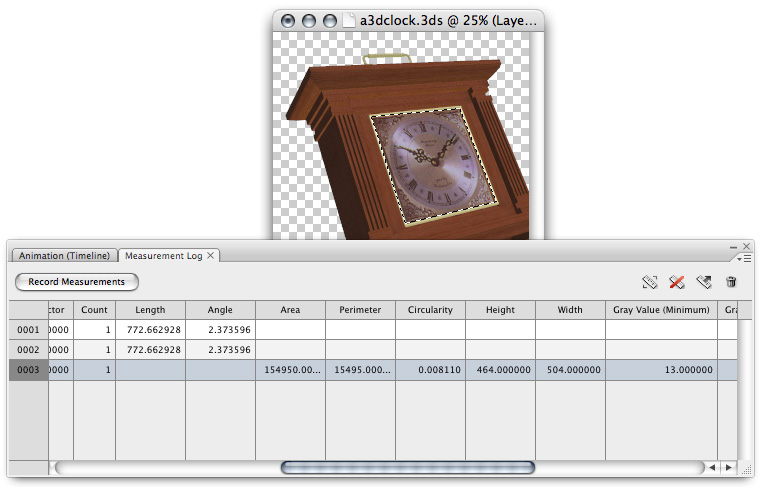 (Click for larger image.)And the rest
(Click for larger image.)And the restPhotoshop CS3 Extended also inherits all of the new features in Photoshop CS3 Standard. We've gone over these in some detail in the past, so I'll just touch on them briefly here:
- New interface, including dockable palettes;
- The ability to use non-destructive, live filters on 2D layers;
- Improvements to Vanishing Point, such as the ability to manipulate the angles of the perspective planes interactively;
- Black and white conversion;
- Improvements to Curves adjustments;
- Adjustable cloning with a preview overlay;
- Adjustable healing with a preview overlay;
- A new "Quick Selection Tool" for masking;
- A "Refine Edge" function for improving selection outlines, including feathering, contraction and expansion, mask previews and other features;
- Automatic layer alignment and blending (for compositing and for merging photos)
- Enhanced "Merge to 32-bit HDR"
- A streamlined interface, with collapsible palettes;
- An update to Camera Raw;
- Integration with Photoshop Lightroom;
- Device Central for exporting to mobile formats;
- A new version of Adobe Bridge, which includes support for filters and the stacking of images, a new loupe tool and previous of Flash content; and
- Improvements to printing.
On top of all that, CS3 Extended also adds support for DICOM and MATLAB files for medical applications. These files can be imported as stacks as well, for applications like animating the layers of a brain scan.
Pricing and availabilityPhotoshop CS3 Extended will be out soon as both a standalone application ($999) and as part of four different CS3 suites, including Design Premium, Web Premium, Production Premium, and the Master Collection.
Pricing for the licenses, which include 500 seats of a given suite edition, is as follows:
- CS3 Design Premium site license: $7,499;
- CS3 Web Premium site license: $7,499;
- CS3 Master Collection site license: $12,499.
The site licenses are available only to K-12 public and private qualifying schools at a single address and include: teacher home use rights and student computers that are owned or leased by the school. Dtails on whether or not the Production Premium edition will be offered in an education site licence package have not yet been released.
In addition, Adobe will also offer education pricing for the boxed applications for individual users. More information about education pricing and site licenses will be available soon on Adobe's K-12 site, linked below.
Upgrade pricing and site licenses are also available. See Adobe's site for more information on additional price configurations.
Photoshop CS3 Extended supports Mac OS X 10.4.8 or higher running on Intel or PowerPC hardware, as well as Windows Vista and XP.
We will continue to bring you more in depth articles covering the applications in Creative Suite 3 over the course of this week. Stay tuned!
Read More::: READ MORE DAILY NEWS ::
About the author: Dave Nagel is the executive editor for 1105 Media's educational technology online publications and electronic newsletters. He can be reached at [email protected].
Have any additional questions? Want to share your story? Want to pass along a news tip? Contact Dave Nagel, executive editor, at [email protected].